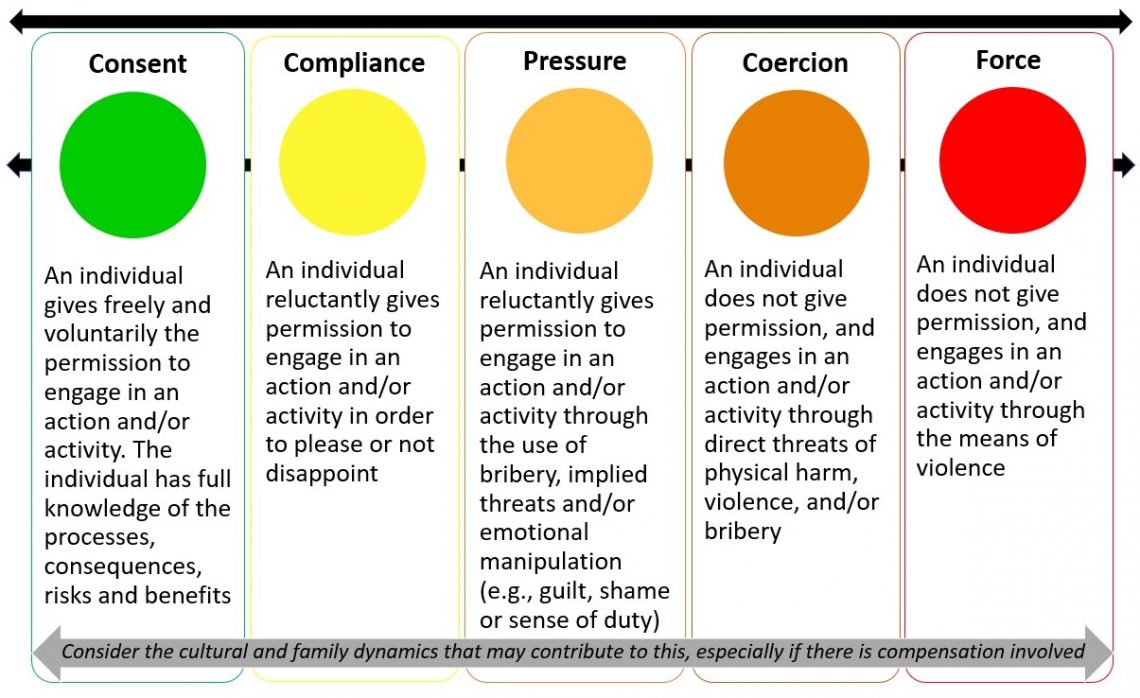Consent
Key messages from this page:
- Talking about consent should start from an early age.
- If someone is in a sexual situation and they don’t want to go further, it is their legal right to change their mind. NO.MATTER.WHAT.
- If someone is in a sexual situation and their partner looks like they might want to stop, it is their job and legal responsibility to check.

Consent is often talked about in the context of some kind of sexual or physical activity with a partner, but in reality, giving consent occurs throughout our lives in many different contexts.
When we are young, consent first means body autonomy. This means that children should be allowed to determine what happens with their body. For instance, not forcing a child to give a hug or kiss if they choose not to.
As we get older, we start to see more situations where we can give what we will call general consent. General consent is used everyday as we get older and may be seen as consenting to share a toy, have your photo taken, or signing a job offer.
Gaining an understanding of consent from an early age helps young people understand that they have a say in many situations. We do acknowledge that sometimes people have to do things that they don't want to, but this does not apply to our next level of consent, sexual consent.
Young people can often tell you what sexual consent means, but find it hard to do in real-life.
In a healthy relationship, both (or all) partners are able to openly talk about and agree on what kind of activity they want to engage in. Whether it’s holding hands, kissing, touching, intercourse, or anything else, it’s really important for everyone in the relationship to feel comfortable with what’s happening. However, in some relationships one partner may be forced by the other to engage in activities that they are uncomfortable with. It is important to remember that compliance or force does not equal consent. Take a look at the consent continuum below, this can be a helpful tool for both you and the young people you work with to be able to identify how different behaviors relate to true consent.
We have also gathered some additional resources below to help you navigate this topic. Some resources are to help you as youth and community workers to gain a better idea of how to support the young people you are working with. While others, are meant to be used alongside young people to ‘do’ consent in real-life.
*Note - State laws on consent differ. Please see the link to Victoria's Legal Aid website on consent for local advice.

Resources
-
Article: Tea and Consent PLUS! Getting beyond legal/illegal. Can we talk about the grey areas?
How do we talk about the kind of sex that most young people are confused by – ‘the grey areas’ often explained as ‘I didn’t say no’ or ‘giving in to get along’. Maybe not illegal, but not ideal, and potentially as devastating.
- Comic: Respecting Choices- Sexual Health and Relationships Education (SHARE) Educational Tool
-
Quiz: Consent and the Law
From the Australian secondary school teaching resource: The Practical Guide to Love, Sex and Relationships.
-
Video: Beyond Consent
-
Video: Consent information for teens
-
Video: Relationships - Consent
Video for young people explaining laws AND how to communicate about consent, from Ballarat Community Health and co-designed with young people.
- Website: Victoria Legal Aid - Age of Consent